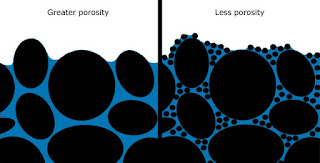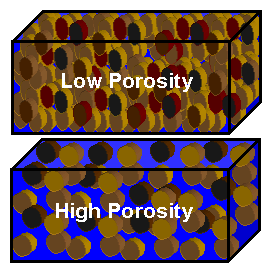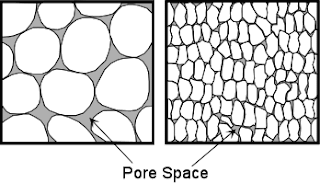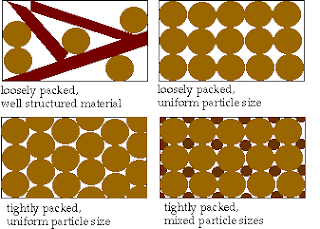The porosity of a rock is the proportion of the non-solid volume to the total volume of
material, and is defined by the ratio:
where V
p is the non-solid volume (pores and liquid) and Vm is the total volume of
material, including the solid and non-solid parts. Both φ and n are used to denote
porosity.
Porosity is a fraction between 0 and 1, typically ranging from less than 0.01 for solid
granite to more than 0.5 for peat and clay, although it may also be represented in percent
terms by multiplying the fraction by 100%.
The porosity of a rock, or sedimentary layer, is an important consideration when
attempting to evaluate the potential volume of hydrocarbons it may contain. Sedimentary
porosities are a complex function of many factors, including but not limited to: rate of
burial, depth of burial, the nature of the connate fluids, the nature of overlying sediments
(which may impede fluid expulsion).
Porosity and hydraulic conductivity
Porosity is indirectly related to hydraulic conductivity. For two similar sandy aquifers,
the one with a higher porosity will typically have a higher hydraulic conductivity (more
open area for the flow of water), but there are many complications to this relationship.
Clays, which typically have very low hydraulic conductivity also have very high
porosities (due to the structured nature of clay minerals), which means clays can hold a
large volume of water per volume of bulk material, but they do not release water very
quickly.
Sorting and porosity
Well sorted (grains of approximately all one size) materials have higher porosity than
similarly sized poorly sorted materials (where smaller particles fill the gaps between
larger particles). The graphic illustrates how some smaller grains can effectively fill the
pores (where all water flow takes place), drastically reducing porosity and hydraulic
conductivity, while only being a small fraction of the total volume of the material.
Types of porosity
• Primary porosity is the main or original porosity system in a rock
• Secondary porosity is a subsequent or separate porosity system in a rock, often
enhancing overall porosity of a rock. This can be a result of chemical leeching of
minerals or the generation of a fracture system. This can replace the primary
porosity or coexist with it (see dual porosity below).
• Fracture porosity is porosity associated with a fracture system or faulting. This
can create secondary porosity in rocks that otherwise would not be reservoirs for
hydrocarbons due to their primary porosity being destroyed (for example due to
depth of burial) or of a rock type not normally considered a reservoir (for example
igneous intrusions or metasediments).
• Vuggy porosity is secondary porosity generated by dissolution of large features
(such as macrofossils) in carbonate rocks leaving large holes, vigs, or even caves.
• Effective porosity (also called open porosity) refers to the fraction of the total
volume in which fluid flow is effectively taking place (this excludes dead-end
pores or non-connected cavities). This is very important in solute transport.
• Dual porosity refers to the conceptual idea that there are two overlapping
reservoirs which interact. In fractured rock aquifers, the rock mass and fractures
are often simulated as being two overlapping but distinct bodies. Delayed yield,
and leaky aquifer flow solutions are both mathematically similar solutions to that
obtained for dual porosity; in all three cases water comes from two
mathematically different reservoirs (whether or not they are physically different).
Measuring Porosity
There are several ways to estimate the porosity of a given material or mixture of
materials, which is called your material matrix.
• The Volume/Density method is fast and suprisingly accurate (normally within 2%
of the actual porosity). To do this method you pour your material into a beaker,
cylinder or some other container of a known volume. Weigh your container so
you know its empty weight, then pour your material into the container.
Tap the side of the container until it has finished settling and measure the volume
in the container. Then weigh your container full of this material, so you can
subtract the weight of the container to know just the weight of just your material.
So now you have both the volume and the weight of the material.
The weight of your material divided by the density of your material gives you the
volume that your material takes up, minus the pore volume. (The assumed density
of most rocks, sand, glass, ect. is assumed to be 2.65g/cc. If you have a different
material, you may look up its density) So, the pore volume is simply equal to the
total volume minus the mateial volume, or more directly (pore volume) = (total
volume) - (material volume).
• Water Saturation Method is slightly harder to do, but is more accurate and more
direct. Again, take a known volume of your material and also a known volume of
water. (Make sure the beaker or container is large enough to hold your material as
well.) Slowly dump your material into the water and let it saturate as you pour it
in. Then seal the beaker (with a piece of parafilm tape or if you don't have
parafilm tape a plastic bag tied around the beaker will do.) and let it sit for a few
hours to insure the material is fully saturated. Then remove the unsaturated water
from the top of the beaker and measure its volume. The total volume of the water
originally in the beaker minus the amount of water not saturated is the volume of
the pore space, or again more directly (pore volume) = (total volume of water) -
(unsaturated water).
• Water Evaporation Method is the hardest to do, but is also the most accurate. Take
a fully saturated, known volume of your material with no excess water on top.
Weigh your container with the material and water and then place your container
into a heater to dry it out. Drying out your sample may take several days
depending on the heat applied and the volume of your sample. Then weigh your
dried sample. Since the density of water is 1 g/cc, the difference of the weights of
the saturated versus the dried sample is eqaul to the volume of the water removed
from the sample (assuming you are measuring in grams), which is exactly the
pore volume. So once again, (pore volume in cubic centemeters) = (weight of
saturated sample in grams) - (weight of dried sample in grams).





No comments:
Post a Comment